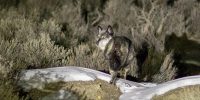|
Catch up on the latest LightHawk news Featured mission: Mexican wolf cross-fostering
LightHawk pilot Ken Adelman, Rebecca Bose and Charlie Duffy of Wolf Conservation Center and representative from the Endangered Wolf Center at a pit stop in Missouri.Photo by Regina Mossotti/Endangered Wolf Center During the early weeks of May, Mexican wolf pups made their way from their home in New York to a wild den in Arizona. The practice, known as cross-fostering, takes a pup, bred in captivity, and places it with a foster mom in the wild. Den locations are found based on the information obtained from the radio collars the adult wolves are wearing. 
Danbury Airport 630am about to leave with precious passenger. Photo by Chris Lovell Experts with our partner, Mexican Wolf Species Survival Program, assess the number of pups that can safely be incorporated into the litter. It is important not to overtax the female wolf. The Mexican wolf was eradicated from the wild in both the US and Mexico. A captive breeding program, initiated from only 7 unrelated wolves, saved the Mexican wolf from extinction. The US Fish and Wildlife Service began releasing Mexican wolves from captivity into the wild in Arizona and New Mexico in 1998. Limited genetic diversity remains a threat to the wild population of Mexican wolves. LightHawk volunteer pilot Ken Adelman picked up a Mexican wolf pup from the Wolf Conservation Center in South Salem, New York, along with Wolf Conservation Center curator Rebecca Bose and veterinarian Charlie Duffy for a flight to Arizona. 
Wolf Conservation Center Curator Rebecca Bose holding Mexican wolf pup before cross foster. Photo by AZGFD George Andrejko The direct flight, in the comfort of the cabin in Ken’s Cessna Citation, ensured the wolf pup arrived in Arizona quickly and with as little stress as possible, including getting fed during a short fuel stop in Missouri. After arrival in Arizona, the pup was placed in a wild den with its new pack. Its presence will increase the genetic diversity of the Mexican wolf population in Arizona. Cross-fostering pups into wild dens allows for these animals to be raised in the wild by experienced wolves. This wolf pup joins an established wolf pair along with new pups and will bolster the Mexican wolf population in the region. We’re grateful for the generosity of volunteer pilot Ken Adelman. These flights require more flexibility around timing and expectations than most LightHawk flights due to unpredictable whelping dates of both wolves in captivity and those in the wild where the pups will be placed. 
Ken Adelman refueling. Photo by Rebecca Bose Additional wolf fostering flights were flown this year by LightHawk volunteer pilots Warren Dean and Joe Keeton 

To view a video about the cross-fostering process, view the video below. Register for AMFI today Early Bird Discount extended! ANNUAL MEETING/FLY-IN Sponsored by Thomas Haas Sept. 23-25 - Washington, DC LightHawk's Annual Meeting and Fly-In is set for September 23-25 at the Smithsonian’s National Air and Space Museum, Steven F. Udvar-Hazy Center. Join us for presentations from aviators and conservation experts. Then enjoy a fabulous dinner at the museum featuring keynote speaker Zora Rutherford, the youngest woman to fly around the world solo. WhenSeptember 23-25, 2022 WhereSmithsonian’s National Air and Space Museum, Steven F. Udvar-Hazy Center CostEARLY BIRD TICKET PRICES LightHawk in the News LightHawk Photo of the Month
Photo by Jon Waterman This month’s photo was taken by photographer Jon Waterman during a flight over southern Colorado’s Sangre De Christo mountains and the Weminuche Wilderness surrounding Alamos and Durango. This, and other photos, will be featured in his upcoming National Geographic book Atlas of American Wilds and a film about wilderness, to be released in 2023. In reference to the project, Waterman says, “Wilderness is an increasingly endangered yet precious commodity. And through my book and a lecture campaign I will be showing the importance of both the legislation and the landscapes - beleaguered in times of mineral and fossil fuel exploitation.” Subscribe to LightHawk’s YouTube channel Have you subscribed to LightHawk’s YouTube channel? We would like to grow this outlet in the future but we need your help! We need a minimum of 100 subscribers to customize our YouTube address. Once we are able to customize the address, it will be easier for others to find it. As the channel grows, we hope to create more content highlighting the work of our volunteer pilots and conservation partners. Please take a moment to subscribe to the LightHawk YouTube channel at the link below. |







